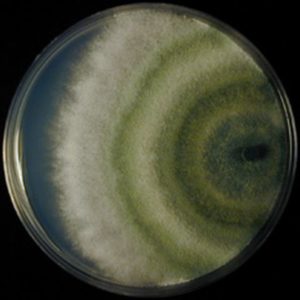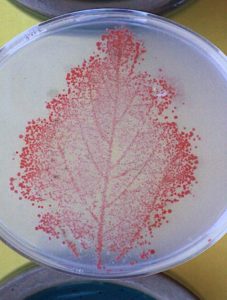Microbial Products Improving Plant Health
Humans are so passé. At least the term describing them is. Many scientists prefer the word “holobiont,” which describes the person along with the myriad bacteria, fungi, and the host of other microbial organisms that contribute to the entity’s overall level of health.

Dr. Molly Cadle-Davidson, Chief Science Officer, Advanced Biological Marketing Inc.
Plants, too, are more than the seeds, roots, stems, leaves, flowers, and fruit. The term that encompasses the plant and the elements that contribute to its health is “phytobiome.”
“Plants are not just the plants,” explains Dr. Molly Cadle-Davidson, Chief Science Officer, Advanced Biological Marketing Inc. “They’re plants plus all the microbes that live on and in the roots, on and in the leaves. There are bacteria, fungi, viruses, nematodes. All of these things are part of a plant.”
When it comes to agriculture these microbial organisms all contribute to the overall health of the crop.
“If you go back in history you can find literature about how to get rid of these bacteria,” says Tom Laurita, CEO of NewLeaf Symbiotics. “It used to be that all bacteria were considered bad. Of course, both in human health and plant health we know it’s the opposite. There are harmful bacteria, but plants, just like people need their entire microbiome to survive and to adjust to stress in their environment.”
Both NewLeaf Symbiotics and ABM develop microbial products that help crops deal with disease-causing biotic and abiotic stresses and other pests. In the case of NewLeaf, it’s pink pigmented facultative methylotrophs (PPFMs), “a large family of organisms that colonize all plants,” Laurita says. “We’ve tested hundreds of different species around the world, leaves, seeds, inside the plants, roots, and we’ve never found a surface of a plant that is not colonized by the bacteria. Humans eat them every day.”
ABM’s product, Trichoderma, is fungus that is generally found in the root of the plant.

Trichoderma is a fungus generally found in the root of the plant.
“The endophytic nature of the Trichoderma is a really important characteristic we’re leveraging,” Cadle-Davidson says. “We want it to be inside the plant roots. That’s what gets you the close communication with the plant. The plant and the Trichoderma respond to the soil environment together. That’s where you get some of the abiotic stress resistance.”
Microbials have been around for decades, but their reputation has been less than stellar. They simply weren’t reliable and the claims suppliers made were often anecdotal and rarely backed by scientific data. That’s no longer the case, Cadle-Davidson says.
“In the past, products didn’t always perform consistently,” she says. “People who might buy our products are coming from a position of doubt. We need to make up ground and provide them with the data and show the responses year over year.”
While there is still much to learn, scientists understand much more about the interaction between plants and their surroundings. “Now that we’ve learned about the phytobiome, ag biologicals make perfect sense,” Cadle-Davidson says.
With companies like Monsanto and Bayer investing in microbial research, “it’s bringing the whole level of the game up, which is great,” Cadle-Davidson says. “Our defense has always been good science.”
Even as microbial products gain acceptance, the traditional crop protection market has nothing to worry about.
“We see ourselves as complementary to the traditional AIs,” Laurita says. “We see lots of opportunity to supplement chemical products, either reduce the amount of chemical needed in certain treatments or increase the efficiency or efficacy of those treatments. We have a lot of interest from industry in what we’re doing.”
NewLeaf and ABM promote their offerings as plant health products and therefore don’t need registration at the federal level. Both, however, have begun the EPA registration process.

Tom Laurita, CEO of NewLeaf Symbiotics
“The bacteria we’re working on are naturally occurring,” Laurita says. “We work closely with the EPA. We have EPA clearance to sell, today, into crops as plant nutrient supplements, just like rhizobia. At the same time, other products we’re working on and testing are going to require registration. We’re submitting two regulatory packages this year to EPA and also PRMA in Canada.”
ABM, which has been around about 17 years, sells its products in 14 different countries. The company has a division in South Africa, where some R&D work is done. It also provides production, sales, and management. “We use that facility to launch into the rest of Africa and Asia,” Cadle-Davidson says. The company has sales in the Ukraine and has done some testing in Romania.
There’s one potential market it has yet to enter.
“The EU is probably the hardest case there is,” she says. “It’s really tough if you’re regular chemistry, but biologicals aren’t treated much differently. It’s really, really hard to get a biological approved in Europe because they are crossing every t and dotting every i. They don’t yet acknowledge the inherent safety in some of these products.”
NewLeaf is only about five years old and plans on delivering its first products this year for the 2017 growing season. “We have a strong product pipeline,” Laurita says. “We have at least 15 candidates that we think are real product opportunities.”
Looking to the future both Laurita and Cadle-Davidson suggest integrating microbials with precision agriculture is the next phase for the segment.

Pink pigmented facultative methylotrophs (PPFMs), have been found on all plants NewLeaf has tested.
Imaging technology already exists that help growers know where exactly they need to put nitrogen, phosphorus, and potassium. Cadle-Davidson foresees a time when the plant’s genotype is so well understood growers will be able to “put the right hybrid with the right biological, knowing ahead of time what kind of soil microbiology they’re planting these things into. It’s incredible to think about. Our computational abilities and power have gotten so much bigger in the last five years.”Laurita agrees.
“Forward-thinking, strategically focused people in agriculture are recognizing two big opportunities,” Laurita says. “One of them is precision ag and the other is biologicals. The market itself, the technology itself, is pushing us in that direction.”
Contact Dan: [email protected]






